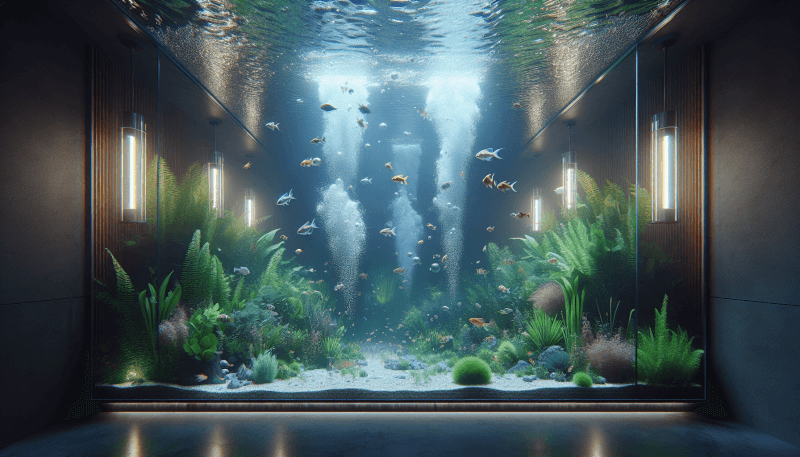Step into a world where vibrant colors, soothing sounds, and mesmerizing movements collide to create a multi-sensory experience like no other. In this article, we explore the captivating realm of aquarium aesthetics and how they can enhance your senses, transport you to another world, and create a soothing ambiance in any space. From the delicate dance of tropical fish to the gentle flow of water plants, prepare to be enthralled and inspired by the endless possibilities for creating an engaging aquarium that can truly captivate all of your senses.

Choosing the Right Aquarium
When it comes to setting up an aquarium, choosing the right size and shape is crucial. A larger aquarium provides more space for the fish to swim and allows for a more stable environment. It is important to consider the dimensions of the room where the aquarium will be placed to ensure it fits perfectly. Additionally, the shape of the aquarium is another factor to consider. Rectangular aquariums are popular choices as they provide a better view of the fish and are easier to maintain compared to curved or hexagonal tanks.
Another decision to make is whether to go for a glass or acrylic aquarium. Glass aquariums are more traditional and have a classic look. They are also scratch-resistant and do not discolor over time. On the other hand, acrylic aquariums are lighter in weight and have a higher impact resistance than glass. They are also available in different shapes and sizes, allowing for more flexibility in design. Ultimately, the choice between glass and acrylic comes down to personal preference and the specific needs of your aquarium.
Lastly, a filtration system is essential for maintaining a clean and healthy environment for your fish. It helps remove waste, toxins, and impurities from the water, ensuring the well-being of your aquatic pets. There are different types of filtration systems to choose from, including mechanical, biological, and chemical filters. It is important to select a filtration system that is appropriate for the size of your aquarium and the type of fish you plan to keep.
Creating the Perfect Lighting
The lighting in your aquarium plays a crucial role in creating a visually appealing and healthy environment for your fish. When it comes to lighting options, you can choose between natural lighting and artificial lighting.
Natural lighting refers to the use of sunlight to illuminate your aquarium. While natural lighting can provide a more realistic and vibrant appearance, it can also lead to excessive algae growth and temperature fluctuations. It is important to consider the location of your aquarium and how much natural light it will receive throughout the day.
Artificial lighting, on the other hand, allows you to have more control over the intensity and duration of light in your aquarium. LED lighting options have become increasingly popular due to their energy efficiency, ability to produce a wide spectrum of light, and customizable features. LED lights also have a longer lifespan compared to traditional fluorescent lights, making them a cost-effective choice in the long run.
Selecting the Right Substrate
Choosing the right substrate is essential for the health and well-being of your aquarium inhabitants. Substrate refers to the material that covers the bottom of the tank and provides a foundation for plants and decorations. There are various types of substrates available, including gravel, sand, and specialized planting substrates.
Gravel is a common choice for beginners as it is easy to clean and does not compact easily. It comes in a variety of colors and sizes, allowing you to create a personalized aesthetic for your aquarium. Sand, on the other hand, creates a more natural look and provides a suitable environment for bottom-dwelling fish species. Specialized planting substrates contain essential nutrients for live plants to thrive and are beneficial for creating a lush, green aquatic landscape.
In addition to the type of substrate, considering the color and texture is also important. Light-colored substrates can help enhance the brightness of the aquarium, making it more visually appealing. Textured substrates, such as gravel with a mix of different sizes, can create a more natural and realistic appearance.
Adding Live Plants
Live plants not only add beauty to your aquarium but also provide numerous benefits for the overall health of your fish. They help oxygenate the water, absorb excess nutrients, and provide natural hiding places for shy or territorial fish. Live plants also contribute to the overall biological balance of the aquarium, helping to prevent algae growth and maintain water quality.
When choosing live plants for your aquarium, it is important to consider their specific requirements in terms of lighting, water temperature, and nutrient levels. Some popular options for beginners include Java Fern, Anubias, and Amazon Sword. These plants are relatively easy to care for and can thrive in a variety of water conditions. It is always best to research the specific needs of each plant and ensure they are compatible with your aquarium setup.

Choosing Suitable Décor
Décor plays a significant role in creating a visually appealing and engaging aquarium. When selecting décor, you have the option of choosing between natural and artificial elements.
Natural décor, such as driftwood and rocks, can help create a realistic underwater environment. It provides hiding places and natural territories for your fish, making them feel safe and secure. Artificial décor, such as resin ornaments and plastic plants, offer a wide range of design options and can be easier to clean and maintain. Mixing natural and artificial elements can create a visually captivating and dynamic aquarium.
It is important to provide hiding spaces for your fish, especially if you have species that are shy or territorial. This can be achieved through the use of rocks, caves, or dense plantings. Hiding spaces not only provide security for your fish but also add depth and dimension to your aquarium.
Integrating Water Movement
Water movement is essential for the health and well-being of your fish and the overall ecosystem of the aquarium. It helps maintain oxygen levels, distributes heat evenly, and prevents the buildup of stagnant water. There are different types of water movement devices available to achieve optimal water circulation.
Importance of water movement can be achieved through the use of aquarium filters, air stones, or water pumps. These devices create water currents and ripples, simulating natural water conditions and enhancing the overall aesthetic appeal of the aquarium. It is important to consider the specific needs of your fish when selecting the type and intensity of water movement.

Optimizing Water Quality
Maintaining optimal water quality is crucial for the health and longevity of your aquarium inhabitants. Proper pH levels, as well as controlling ammonia and nitrate levels, are essential aspects of water quality management.
Monitoring and maintaining the pH levels within the appropriate range is important for the overall health and well-being of your fish. Different species of fish have different pH preferences, so it is essential to research the specific requirements of your fish. Regular water testing and the use of pH adjusters or buffers can help maintain a stable pH level.
Controlling ammonia and nitrate levels is also crucial for the health of your fish. High levels of ammonia and nitrate can be detrimental to their well-being and can lead to stress or even death. Regular water testing, proper filtration, and regular water changes are effective methods for controlling these levels and ensuring water quality.
Considering Aquascaping Techniques
Aquascaping refers to the art of creating underwater landscapes in aquariums. It involves arranging plants, rocks, and other décor elements to create visually captivating and natural-looking scenes. There are different techniques you can use to enhance the aesthetics of your aquarium.
Creating depth and perspective is an essential aspect of aquascaping. This can be achieved by placing taller plants or décor elements in the background and gradually decreasing their size towards the front. This creates an illusion of depth and makes the aquarium appear larger than it actually is.
Using different heights and layers is another technique that can add visual interest to your aquarium. This involves arranging plants and décor elements at various heights, creating a sense of dimension and complexity. The use of foreground plants, midground plants, and background plants can help create a balanced and visually appealing layout.

Implementing Sound Effects
Sound effects can add another dimension to the overall sensory experience of your aquarium. Waterfall or bubble features can create a soothing and calming atmosphere. The gentle sound of water cascading or bubbles rising can enhance the relaxation and enjoyment of observing your aquatic pets.
In addition to water features, you can consider adding aquarium music or soundtracks. These can range from natural underwater sounds, such as ocean waves or rainforest ambience, to calming and peaceful music. The choice of sound effects depends on your personal preference and the overall theme or mood you want to create in your aquarium.
Enhancing with Backgrounds
Backgrounds can greatly enhance the visual appeal of your aquarium. They provide a backdrop for your aquascape and can help create a more immersive and realistic underwater environment. There are different types of backgrounds to choose from, including natural scenery backgrounds and 3D or illusion backgrounds.
Natural scenery backgrounds can depict various underwater landscapes, such as coral reefs, rocky caves, or lush green forests. These backgrounds add depth and perspective to your aquarium, making it appear larger and more vibrant. 3D or illusion backgrounds create a three-dimensional effect, giving the illusion of greater depth and complexity.
When selecting a background, it is important to consider the overall theme and aesthetic of your aquarium. It should complement the décor, lighting, and aquascaping of the tank, creating a cohesive and visually appealing display.
In conclusion, creating an engaging and aesthetically pleasing aquarium involves careful consideration of various factors. From choosing the right aquarium size and shape to selecting suitable lighting, substrate, live plants, décor, water movement devices, and optimizing water quality, each aspect contributes to the overall sensory experience of your aquarium. By implementing aquascaping techniques, incorporating sound effects, and enhancing with appropriate backgrounds, you can create a multi-sensory experience that captivates and delights both you and your aquatic pets. So go ahead, let your creativity flourish and create the aquarium of your dreams!


